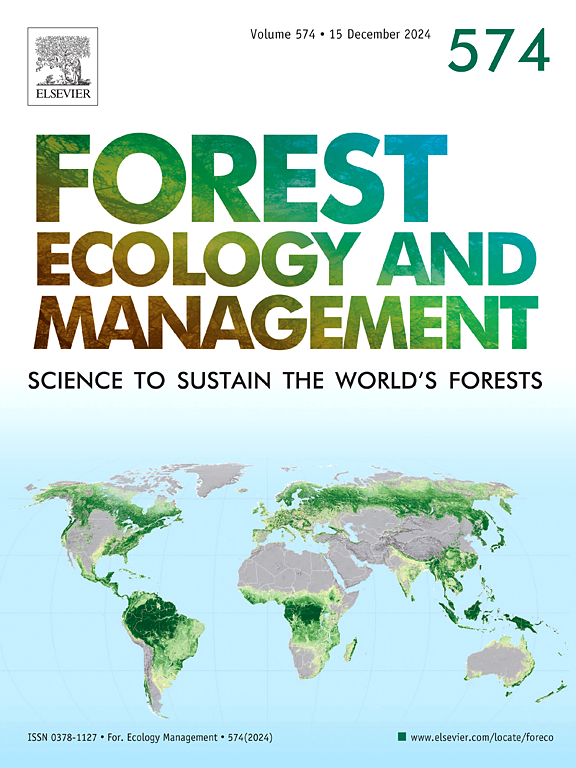利用森林清查和分析数据模拟美国南部天然硬木林的生长和产量
IF 3.7
2区 农林科学
Q1 FORESTRY
引用次数: 0
摘要
生长和产量模型(GYMs)对于可持续森林管理和造林决策至关重要。然而,大多数林分水平模型依赖于年龄和相关变量,如站点指数,这些通常不适用于天然硬木林。为了解决这个问题,我们开发了独立于年龄的天然硬木林分的gym,使用将长入、死亡率和存活生长的变化率与初始林分条件联系起来的微分方程。利用美国南部森林清查分析(FIA)项目中1540个永久样地的数据,建立了一些重要森林类型的微分方程系统(SDE)。这些SDEs的数值解提供了林分属性随时间的预测,用于获得林分直径的分布。我们使用来自田纳西州的独立FIA数据集对SDE进行了评估,结果显示出很强的一致性,预测的林分属性(如基底面积、密度、直径和体积)与观测值非常吻合。在两次规定的插枝后,林分发育产生了自然林分的模式。将SDE进一步应用于平均年龄的薄林分,得到了与现有模拟器相当的可靠估计。SDE可以在混合年龄和平均年龄的林分中实施。本文章由计算机程序翻译,如有差异,请以英文原文为准。
Modeling the growth and yield of natural hardwood stands in the southern United States using the Forest Inventory and Analysis data
Growth and yield models (GYMs) are essential for sustainable forest management and silvicultural decisions. However, most stand-level models rely on age and related variables like site index, which are often unavailable for natural hardwood stands. To address this, we developed GYMs for natural hardwood stands independent of age, using differential equations that relate the rate of change in ingrowth, mortality, and survivor growth to the initial stand conditions. Data from 1540 permanent plots in the Forest Inventory Analysis (FIA) program across the southern United States were used to develop the systems of differential equations (SDE) for some important forest types. The numerical solution of these SDEs provided predictions of stand attributes over time, which were used to obtain diameter distributions. We evaluated the SDE using an independent FIA dataset from Tennessee, and the results showed strong consistency, with predicted stand attributes such as basal area, density, sum of diameters, and volume aligning closely with observed values. Stand development after two prescribed cuttings produced patterns expected of a natural stand. Further application of the SDE to even-aged thinned stands produced reliable estimates comparable to those from an existing simulator. The SDE can be implemented in both mixed-age and even-aged stands.
求助全文
通过发布文献求助,成功后即可免费获取论文全文。
去求助
来源期刊

Forest Ecology and Management
农林科学-林学
CiteScore
7.50
自引率
10.80%
发文量
665
审稿时长
39 days
期刊介绍:
Forest Ecology and Management publishes scientific articles linking forest ecology with forest management, focusing on the application of biological, ecological and social knowledge to the management and conservation of plantations and natural forests. The scope of the journal includes all forest ecosystems of the world.
A peer-review process ensures the quality and international interest of the manuscripts accepted for publication. The journal encourages communication between scientists in disparate fields who share a common interest in ecology and forest management, bridging the gap between research workers and forest managers.
We encourage submission of papers that will have the strongest interest and value to the Journal''s international readership. Some key features of papers with strong interest include:
1. Clear connections between the ecology and management of forests;
2. Novel ideas or approaches to important challenges in forest ecology and management;
3. Studies that address a population of interest beyond the scale of single research sites, Three key points in the design of forest experiments, Forest Ecology and Management 255 (2008) 2022-2023);
4. Review Articles on timely, important topics. Authors are welcome to contact one of the editors to discuss the suitability of a potential review manuscript.
The Journal encourages proposals for special issues examining important areas of forest ecology and management. Potential guest editors should contact any of the Editors to begin discussions about topics, potential papers, and other details.
 求助内容:
求助内容: 应助结果提醒方式:
应助结果提醒方式:


